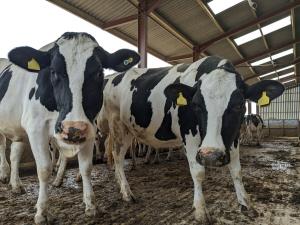
By Vet Dan Lawson
Having a closed herd is the best protection from bringing new diseases onto a farm. However, this isn’t always possible, therefore excellent biosecurity is the next best option.
The introduction of new stock is one of the biggest threats to the health of any herd. It is important to take steps to reduce the risk of diseases being brought onto the farm, to maintain the health of the herd and concurrently the welfare, productivity and profitability.

Before purchasing new stock, you can take steps to reduce the risks involved. These include finding out as much as possible about the animals you plan to buy. It is important to find out about the general health of the herd and their vaccination status.
Animals may have an infection, but it isn’t always easy to identify. Some animals may also be carriers of disease for some time after recovering from the initial infection. Isolation is a key step for reducing disease spread into the herd and this must apply to any new stock being introduced including borrowed animals. This is a perfect opportunity to undertake testing before they join the herd and carry out any planned vaccinations or treatments.
Isolation means no direct contact between new stock and the existing herd, as well as no contact between the waste from each group of stock. Ideally a separate building should be used, as far away from the existing herd as possible. When cattle are out at grazing, a separate field with a 3m boundary between fields should be used for new stock.
Dairy cattle that are lactating pose a more complex issue. In this case any new stock should only be brought into the collecting yard and parlour after the main herd.
TB – assess the testing history of the herd you are buying from, taking note of when the last test was undertaken, and assess the TB status of the surrounding holdings using the ibTB map. You should also consider pre and post movement testing before mixing cattle with your herd.
Johnes – this disease is difficult to see, especially in young animals due to the long incubation period. The Cattle Health Certification Standards Scheme (CHeCS) is a useful tool, as it certifies the risk level for Johnes in each herd.
BVD – this can present with a wide array of clinical signs and can cause a large financial loss. The health status of the herd the cattle are coming from should be ascertained. There are also tests that can be done to assess individual animals. Persistently infected animals must never be bought!
Campylobacter – this disease is especially important to consider when using natural service, sweeper bulls or sharing a bull with other farms. It is sexually transmitted, causing abortions and poor conception rates. A closed herd is best, if this is not possible a policy of purchasing virgin heifers and bulls only is best.
IBR – this causes respiratory disease and a carrier status is often developed after infection. Therefore, you should always ascertain the animals’ health status, which includes its vaccination status and the product used.
Bringing new stock onto the farm is never without risk. However, by taking steps to assess the health and vaccination status of the herd of origin, and carrying out suitable testing and isolation protocols, these risks can be reduced. The herd health plan should give more detail on biosecurity and strategies which will have been discussed with your veterinary surgeon.